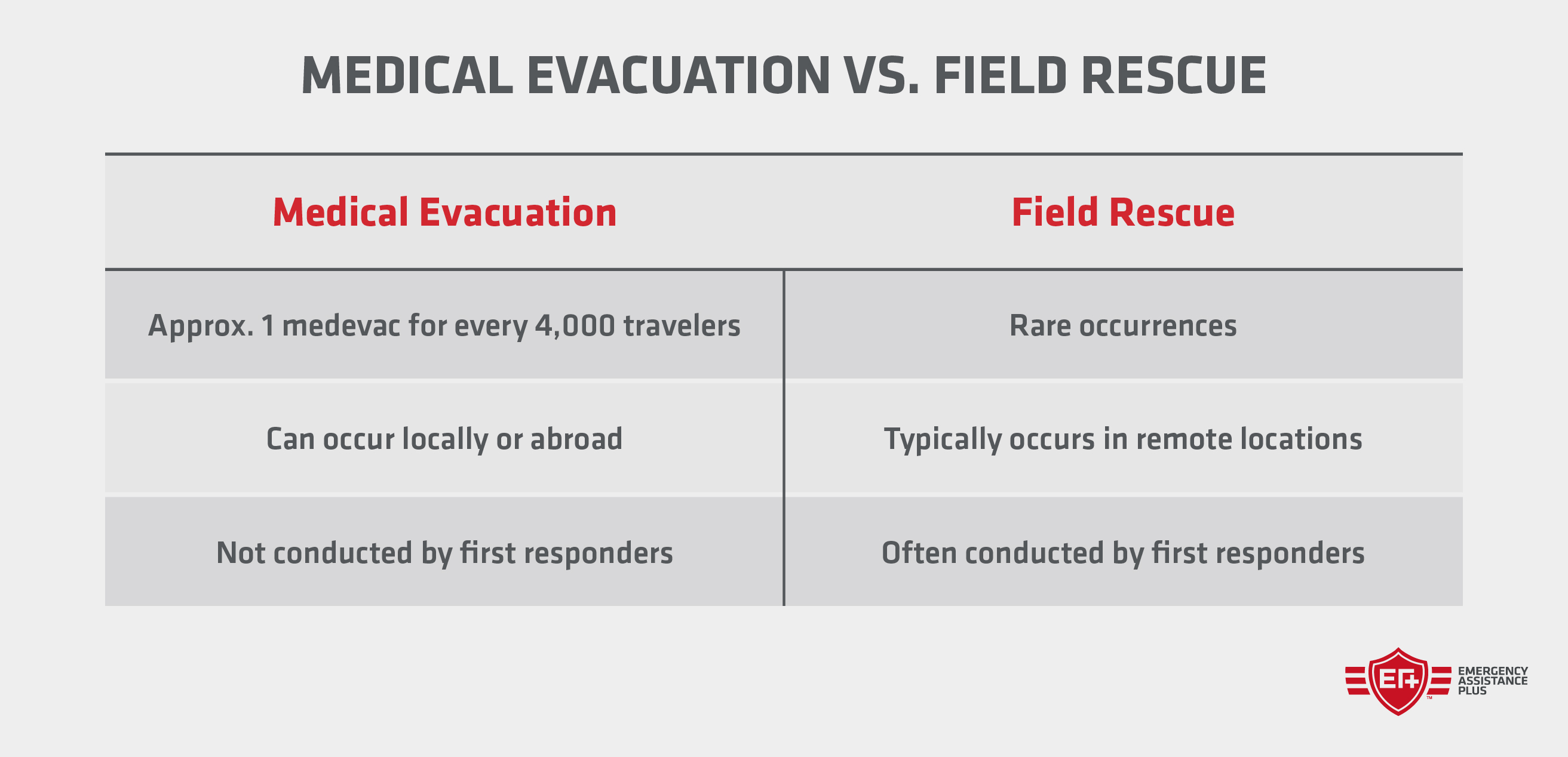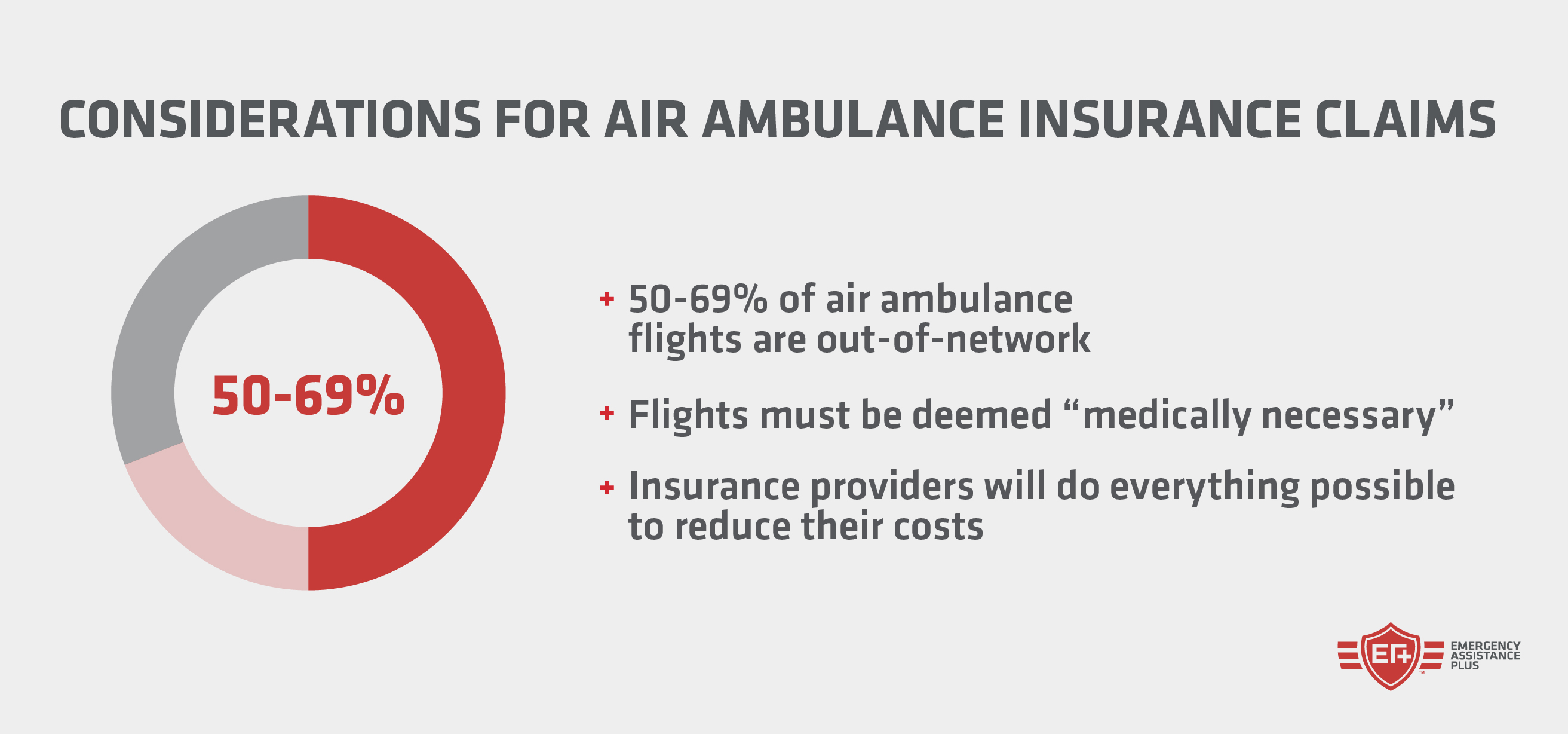Medical Evacuation
Your questions about international travel and health insurance answered!
Medical emergencies are never good, and when they lead to a necessary medical evacuation, they’re (obviously) much worse.
The medical evacuation cost can be substantial, whether by air or ground. Factors such as distance, equipment, and personnel all influence these expenses, as well as what type of insurance or travel assistance you carry.
This article will walk you through the costs and considerations you need to know, and hopefully provide peace of mind when it matters most.
Medical evacuation is the process of transporting individuals who are injured, wounded, or ill from one location to another for medical treatment. This type of evacuation is typically employed in situations where the individual’s medical condition requires urgent attention, and the available medical facilities at the current location may be insufficient to provide the necessary care.
Medical evacuation can involve various modes of transportation, including helicopters, ambulances, fixed-wing aircraft, or even specially equipped vehicles. The goal is to swiftly and safely move the patient to a medical facility where they can receive appropriate medical care.
Note that when an individual needs to be evacuated from a remote area like a mountain peak or otherwise inaccessible area, this is often referred to specifically as a “field rescue.” Field rescues are much more rare than traditional medical evacuations and may incur different procedures, coverages, and costs.

Now let’s look into what makes up the actual cost of medical evacuation. These services, including medical transportation, don’t come cheap. The costs can be substantial, running into tens of thousands of dollars, and they vary based on several factors:
Air ambulance, ground ambulance, and commercial flights are three prevalent methods of medical evacuation. Each has a unique cost structure—let’s examine each of these methods more closely.
Air ambulance services provide rapid transportation in critical medical emergency situations. These services are particularly crucial when the patient is in a remote area or when speed is of the essence.
The pricing for air ambulance services is determined by factors such as the length of the flight, fuel usage, upkeep expenses, the onboard medical team, and flight staff (pilot, co-pilot, etc.). Additionally, there could be supplementary expenses beyond the base price, including per-mile charges and variations based on private health insurance.
The National Association of Insurance Commissioners reports that the average air ambulance trip within the U.S. is about 52 miles, with a cost ranging between $12,000 and $25,000 per flight. Depending on where you are outside of the U.S., you can expect it to cost significantly more:
Ground ambulance services are typically used for shorter distances, such as transportation within a city or to the nearest medical facility. The costs here are generally lower than air ambulance services but can still be significant.
The cost of ground ambulance services can increase significantly with distance, as charges are often based on a per-mile rate. Additionally, there may be potential fees, including temporary add-on payments and out-of-network charges for ambulance-related services.
Many ambulance rides are considered out-of-network, which means you may be on the hook for the bill. The average cost for a ground ambulance in California (which is the highest in the country) is $1,209. (U.S. PRIG).
Commercial flights can also be used for medical evacuation in certain situations, typically when the patient’s condition is stable and an emergency evacuation is not required. This method of medical evacuation can be more affordable than air and ground ambulance services.
Commercial flight medical evacuation, however, has its unique set of costs including the need to buy multiple seats for stretcher accommodation and airport handling charges. The type of medical condition is also a crucial factor, as not all conditions are suitable for this type of evacuation.
Additionally, if you need a nurse escort, that will affect the price. Common reasons someone might require a nurse escort include: Medical transfers, repatriation, long-distance travel arrangements for those with specialized medical needs, and general health and safety concerns.
At the low end, medical evacuation via commercial flight can be as little as the cost of your airline ticket.
Note: With an Emergency Assistance Plus® (EA+®) membership, EA+ will arrange and provide medical evacuation services, at no charge to you, for qualifying cases. Learn more about this travel assistance membership here.
This is always a little tricky to answer because it depends on an individual’s specific policy.
If your health insurance plan does cover air emergency evacuation, your costs might be as low as your copay and/or out-of-pocket maximums. The key part of insurance coverage is that the medical evacuation is deemed “medically necessary,” which can be somewhat of a gray area when it comes time to file a claim.
There are many examples of disputes between insurance companies and their customers regarding unexpected bills for medical evacuation.

In short, you’ll need to consult your insurance provider for a specific answer.
Considering the potential high expenses of medical evacuation out of pocket, securing some type of protection is an important decision. The question is: What type of coverage or protection is right for you?
Various options exist, each presenting its own set of advantages and drawbacks.
Standalone plans, comprehensive travel insurance, and travel assistance memberships are the three primary types of protection offering medical evacuation coverage. A closer look at each of these options, as well as considering medical evacuation travel insurance, can help determine the best fit for your needs.
Standalone medical evacuation plans focus solely on covering the costs of medical evacuation. They are designed to complement your existing health coverage and can be tailored to specific needs and situations that call for air ambulances.
These plans can be particularly beneficial for adventure travelers and those with pre-existing conditions. They provide emergency medical coverage for transportation to the nearest suitable treatment facility and may also include coverage for repatriation to your home country if medically necessary.
Comprehensive travel insurance is another option to consider. This type of insurance, also known as a comprehensive travel insurance plan, covers a wide range of travel-related risks, including travel medical expense insurance, which covers:
However, it’s important to note that comprehensive travel insurance generally has higher costs than standalone medical evacuation plans.
Related reading: Everything You Need to Know About Annual Travel Insurance
While growing in popularity, travel assistance programs are still somewhat of a hidden gem for travelers concerned about medical evacuation costs. Unlike insurance plans which reimburse you after you receive medical care, travel assistance protection actually offers you help in coordinating the care in your time of need.
For example, if you’re away from home and become hospitalized and need specialized medical treatment at a more appropriate hospital, EA+ will arrange and provide ground or air ambulance transportation at no cost as part of your membership.
While traveling in the Canary Islands, a member suffered a seizure and was hospitalized. Due to the member’s condition and restrictions related to COVID-19, the member needed to be transported back to the U.S. for rehabilitation. An air ambulance was quickly secured to transport the member from the hospital to their home in Michigan.
Total cost provided by EA+: $85,653
Total out-of-pocket cost for member: $0
*The story herein is a true member experience. The names of the individuals and certain details have been changed to protect member privacy. EA+ offers a variety of membership plans with different service levels. The services described are based on the specific EA+ membership plan that these members purchased. Please review your Member Guide carefully to understand all services available to you, as well as any rules and regulations.
Read more EA+ member stories here.

While it can seem overwhelming to calculate the required medical evacuation coverage, it’s a vital step towards ensuring adequate protection during your travels.
Several considerations can shape your coverage needs, such as:
Let’s explore each of these factors.
The nature of your travel—whether domestic or international—can significantly impact your medical evacuation coverage needs. Healthcare facilities and infrastructure vary widely around the world, and thus, so do the potential costs of medical evacuation. Note that medical evacuation may or may not be covered by your health insurance plan.
For international travel, it’s recommended to have a minimum coverage of $100,000 for medical evacuation due to potentially higher costs compared to domestic travel. This is because medical evacuation costs can exceed $30,000, even within North America.

If you’re an adventure traveler or heading to remote locations, your emergency medical evacuation coverage needs can be significantly higher. These situations often involve increased risks and limited access to medical facilities, making emergency evacuation coverage essential.
In such scenarios, it’s advisable to have a minimum of $250,000 in coverage. This takes into account the higher costs of medical evacuation from remote areas and the potential need for specialized medical care.
Note: EA+ offers an Expanded Evacuation add-on for things like natural disaster, rioting, terrorism, nuclear accident or military uprising. Learn more here.
Pre-existing medical conditions can also influence your medical evacuation coverage needs. If you have a pre-existing condition, you may need to seek additional coverage or waivers to ensure you’re adequately protected.
Without a pre-existing condition exclusion waiver, a travel insurance company may not cover medical bills or claims related to your recent medical history. However, with the exclusion waiver, the company cannot review your recent medical records when evaluating a medical-related claim.
In conclusion, medical evacuation can be a lifesaver in an emergency during travel. However, the potential high costs associated with it highlight the importance of having adequate coverage.
By understanding the different types of medical evacuation, insurance and non-insurance options, and coverage needs, you can make an informed decision about the best insurance for you.
Travel with peace of mind, knowing that you’re adequately protected should a medical emergency occur.
EA+ travel assistance memberships are crafted to give travelers the confidence to embark on their journeys, assured that in the event of a medical emergency, a team of highly skilled professionals are ready to ensure they receive appropriate medical attention and are arranged for the required transportation back home.
Check out our plan information on our website or give us a call at: 866-863-4460.

Medical Evacuation

Medical Evacuation

Medical Evacuation

Medical Evacuation

Medical Evacuation

Medical Evacuation